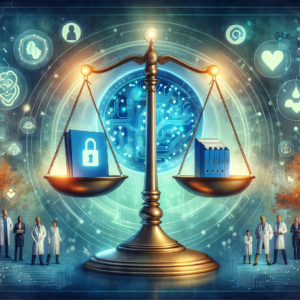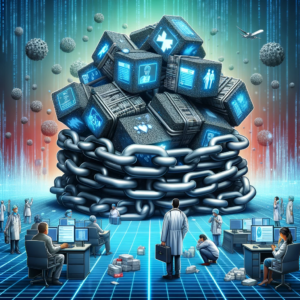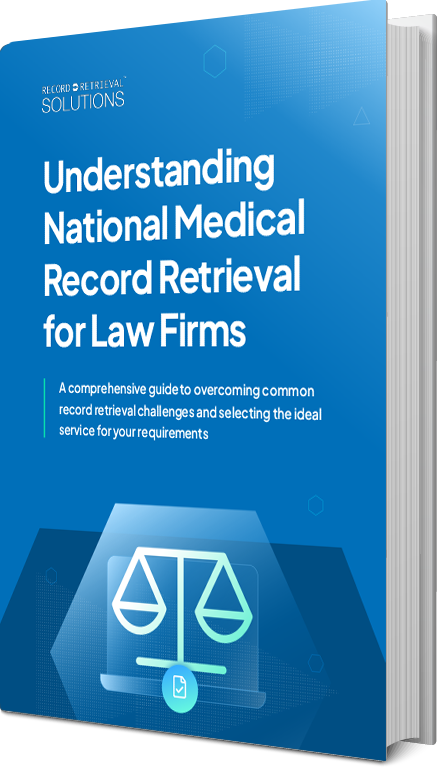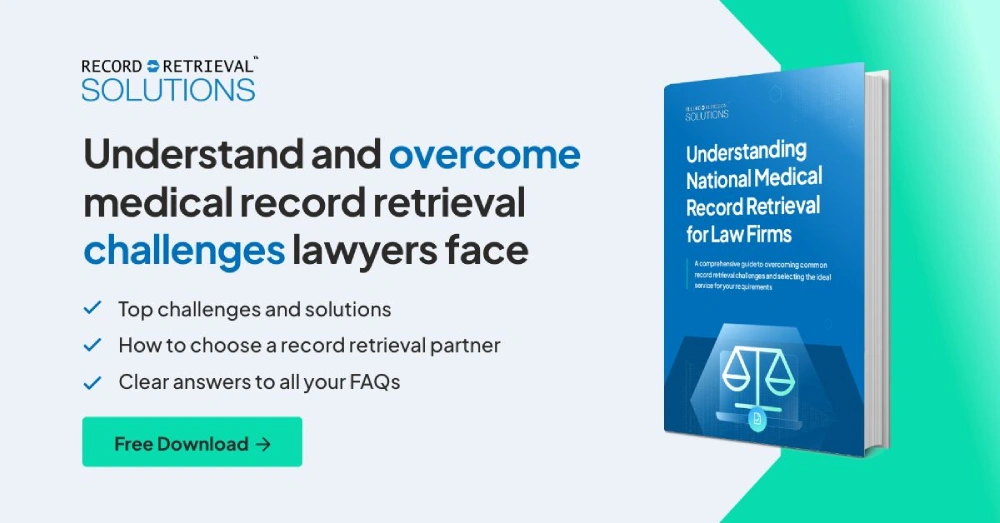Understanding Blockchain Technology
Blockchain technology, initially associated with cryptocurrencies like Bitcoin, has found a significant role in various industries, including healthcare. Its unique characteristics offer transformative solutions to some of the most pressing challenges in medical record management.
Decentralized and Distributed Ledger
What is Blockchain?: At its core, blockchain is a decentralized and distributed digital ledger. Unlike traditional databases that store data in a centralized location, blockchain distributes its data across multiple computers or nodes in a network. This design means that each transaction or record entered into the blockchain is replicated across the entire network.
Immutability and Security: One of the most critical aspects of blockchain is that once data is entered, it cannot be altered retroactively. This immutability is ensured through complex cryptographic algorithms. Each transaction or record on the blockchain is encrypted and linked to the previous one, creating a secure and unchangeable chain of data blocks.
Enhancing Patient Data Integrity and Privacy
Securing Patient Data: The encrypted and immutable nature of blockchain offers a highly secure platform for managing patient data. This level of security is crucial in healthcare, where data integrity and patient privacy are of utmost importance. Blockchain technology ensures that patient records are not only secure from unauthorized access but also accurate and unaltered.
Reducing Data Breach Incidents
Eliminating Centralized Databases: Traditional hospital databases are often centralized, making them susceptible to hacking and data breaches. Blockchain technology proposes a different approach by decentralizing the storage of data. This decentralization significantly reduces the risk of mass data breaches, as there is no single point of failure.
Improving Interoperability in Healthcare
Seamless Data Exchange: A significant challenge in healthcare is the interoperability of systems, where different healthcare providers often use incompatible systems for managing medical records. Blockchain can bridge this gap by allowing seamless data exchange between these varied systems, thereby improving coordination and the quality of patient care.
Promoting Patient Rights and Data Ownership
Consent and Authorization: Blockchain technology can facilitate patient consent and authorization mechanisms for data sharing. This feature is particularly important in healthcare, where patients’ rights and data ownership need to be respected. Patients can have more control over who accesses their medical records and for what purpose.
Enhancing Traceability and Accountability
Auditing and Management: The traceability and accountability of medical records are significantly enhanced with blockchain technology. Since each transaction is recorded and time-stamped on the blockchain, it becomes easier to track changes, access, and updates to patient records, simplifying auditing processes and data management.
Real-Time Data Updates
Up-to-Date Patient Records: Blockchain technology allows for the real-time updating of medical records. As soon as a record is added or modified, it is immediately reflected across the entire network. This feature ensures that healthcare providers always have access to the most current and comprehensive patient information.
Enabling Smart Contracts in Healthcare
Automating Administrative Tasks: Blockchain can facilitate the use of smart contracts – self-executing contracts with the terms of the agreement directly written into code. In healthcare, this could translate to automated billing and claims management, reducing administrative overhead and improving operational efficiency.
In conclusion, blockchain technology offers a robust, secure, and efficient framework for managing medical records in healthcare. Its ability to enhance data integrity, improve interoperability, protect patient privacy, and streamline administrative processes positions it as a revolutionary tool in reshaping the future of healthcare operations and patient care delivery.
The Current State of Medical Record Management
The Conventional Way of Managing Medical Records
The management of medical records has undergone significant transformations over the years. Understanding the traditional methods provides a clear contrast to the innovations brought by technologies like blockchain.
Physical Format: Paper Files
Traditionally, medical records were predominantly stored in physical formats, primarily paper files. This method involved maintaining handwritten notes, printed reports, and documents in patient files. These physical records required extensive storage space, especially for hospitals and clinics with a large number of patients. Managing these paper files also posed challenges in organization, retrieval, and maintenance. Over time, as patient records accumulated, healthcare facilities faced the burden of storing mountains of paper, which not only took up significant space but also increased the risk of damage or loss of records.

Transition to Electronic Health Records (EHRs)
To address the limitations of paper records, Electronic Health Records (EHRs) were developed. EHRs represent the digitization of patient records, allowing healthcare providers to create, manage, and consult patient information electronically. This shift marked a significant advancement in medical record management, offering numerous benefits such as easier data entry, better organization, and reduced physical storage needs.
However, EHRs are not without their challenges. One of the main issues is that they typically require centralized storage and management. This centralization often means that patient data is stored in servers managed by either the healthcare provider or a third-party service provider. While centralization has its advantages in terms of data consolidation and management, it also introduces risks such as data breaches and server downtimes, which can impede access to critical patient information.
Lack of Interoperability
A major drawback of many conventional EHR systems is their lack of interoperability. Interoperability refers to the ability of different systems and software applications to communicate, exchange data, and use the information that has been exchanged. In the context of EHRs, interoperability issues arise when different healthcare providers use systems that are incompatible with one another. This incompatibility makes it difficult to share and access patient information across various healthcare providers.
For instance, a patient’s records in a primary care physician’s office might not be readily accessible to a specialist or a hospital if they are using different EHR systems. This lack of seamless data exchange can lead to inefficiencies in patient care, such as redundant tests, incomplete patient history, and potential delays in treatment.
While traditional methods of managing medical records, including the use of physical files and centralized EHRs, have served their purpose, they come with significant limitations. The issues of storage space, risk of data loss, centralized management vulnerabilities, and lack of interoperability highlight the need for more advanced solutions in medical record management, paving the way for innovations like blockchain technology.
Challenges Faced in Current Medical Record Management
The management of medical records, despite advancements in technology, still encounters several significant challenges. These issues can impact the quality of patient care, the efficiency of healthcare services, and the security and privacy of patient data.
Data Security and Privacy Concerns
One of the primary challenges in current medical record management systems is ensuring the security and privacy of patient data. These systems are often the targets of cyberattacks, leading to data breaches that can have far-reaching consequences. The sensitive nature of medical records makes them a valuable target for hackers, who can exploit vulnerabilities in the system’s security to gain unauthorized access. This not only risks the privacy of patients but also places healthcare providers in a precarious position regarding legal compliance and trustworthiness.
Inconsistencies and Errors in Patient Data
Another significant issue in the management of medical records is the potential for inconsistencies and errors. This often stems from manual entry or the transfer of patient data between different systems or departments. Errors can occur during the transcription of patient information, during the transfer of records between healthcare providers, or through misinterpretation of handwritten notes. These inaccuracies can lead to misdiagnoses, inappropriate treatment plans, and overall reduced quality of patient care.
Fragmentation of Patient History
A further challenge is the fragmented nature of patient history within the current systems. Medical records are often scattered across various healthcare providers, each using different systems for record-keeping. This fragmentation makes it challenging to access a patient’s comprehensive medical history, leading to inefficiencies and delays in patient care. Healthcare providers may have to spend considerable time gathering information from various sources to get a complete picture of a patient’s medical history. This not only is time-consuming but also can lead to incomplete information, which might adversely affect treatment decisions.
Each of these challenges highlights the need for more integrated, secure, and efficient systems for managing medical records. Addressing these issues is crucial for improving the quality of healthcare services, safeguarding patient data, and enhancing the overall efficiency of medical record management.
The Need for Change in the System
The healthcare industry, particularly in the realm of medical record management, stands at a crossroads. The current challenges surrounding data security, interoperability, and efficiency underscore an urgent need for systemic change. Such a transformation is not just a matter of enhancing operational efficiencies but is imperative for safeguarding patient health, privacy, and improving the overall quality of healthcare.

Addressing Data Security and Privacy
One of the most pressing concerns in the existing system is the security and privacy of patient data. With the increasing frequency and sophistication of cyber threats, traditional methods of storing and managing medical records are proving inadequate. A revised system must prioritize robust security protocols to protect sensitive patient information from unauthorized access and breaches. This involves not only employing advanced encryption and cybersecurity measures but also ensuring compliance with regulations such as HIPAA (Health Insurance Portability and Accountability Act) and GDPR (General Data Protection Regulation), which govern data privacy.
Enhancing Interoperability Among Healthcare Providers
Interoperability remains a significant hurdle in the current healthcare landscape. The ability for different systems and software to communicate seamlessly is vital for efficient and effective patient care. The new system should facilitate easy and secure sharing of medical records across various healthcare providers. This integration would ensure that healthcare professionals have timely and comprehensive access to patient histories, regardless of where the patient received prior care. Such connectivity is crucial for accurate diagnoses, appropriate treatment plans, and avoiding redundant tests and procedures.
Improving System Efficiency and Reducing Errors
The existing medical record management systems are often riddled with inefficiencies and prone to errors, largely due to manual data entry and the use of disparate systems. The revamped system should leverage technology to automate and streamline processes, reducing the likelihood of human error. This includes implementing more sophisticated data entry and retrieval systems, utilizing artificial intelligence for data analysis, and ensuring that data is consistently updated and accurate. Reducing errors and redundancies not only improves patient care but also significantly cuts down on administrative costs and resource wastage.
The urgency for a transformative overhaul in medical record management systems is clear. A system that robustly safeguards data security, bolsters interoperability, and streamlines efficiency is crucial for the evolution of healthcare. These improvements are vital not just for tackling current challenges but also for laying the groundwork for a healthcare system that is more cohesive, patient-focused, and adaptable to future technological advancements and healthcare needs.
The Concept of Blockchain in Medical Record Management
The integration of blockchain technology into medical record management marks a significant shift from traditional systems, promising enhanced security, transparency, and efficiency in handling patient health data.
Decentralized and Distributed Ledger Technology
At the heart of this paradigm shift is the application of blockchain as a decentralized, distributed ledger technology in healthcare. Unlike conventional databases that store data in a central location, blockchain distributes it across a network of computers. This decentralized nature ensures that no single entity has control over the entire dataset, thereby enhancing security and reducing the risks of data manipulation and breaches.
Encryption and Immutability of Data
Each piece of data, or block, in a blockchain is securely encrypted and linked to the previous block in the chain. This linkage is crucial as it makes the data nearly immutable – once recorded on the blockchain, it becomes exceedingly difficult to alter without detection. This feature is particularly important in medical record management, where the integrity and accuracy of patient information are paramount.
Digitization of Patient Records
The adoption of blockchain technology in medical records necessitates the digitization of all patient data. This involves converting existing paper records into digital format and ensuring that all new patient information is captured electronically. Digitization is a critical step as it allows medical data to be easily and securely incorporated into the blockchain.
Secure Storage and Access
Once digitized, these medical records are stored on the blockchain network. A significant advantage of this method is that it can offer robust security protocols and access controls. The blockchain network is designed in such a way that only authorized personnel can access the patient data. This controlled access is critical in maintaining patient privacy and complying with healthcare regulations like HIPAA in the United States.
The adoption of blockchain in medical record management is not just about adopting a new technology; it’s a reimagining of how patient data is handled, stored, and shared in the healthcare ecosystem. By leveraging the unique attributes of blockchain, healthcare organizations can enhance the security, reliability, and efficiency of medical record management, thereby improving patient care and trust in the healthcare system.
Benefits of Using Blockchain in Medical Record Management
Enhanced Security
One of the most significant benefits of implementing blockchain technology in medical record management is the heightened level of security it offers. In an industry where data confidentiality and integrity are paramount, blockchain provides a robust solution to safeguard sensitive medical information.
Robust Security of Medical Records
Blockchain’s unique structure and operational mechanism inherently enhance the security of medical records. Every transaction or entry on a blockchain is encrypted and then linked to the previous transaction, creating a chain of data blocks. This encryption ensures that each piece of data is securely stored, providing a high level of protection against unauthorized access and tampering.
Decentralization as a Barrier to Data Manipulation
The decentralized nature of blockchain is one of its key features contributing to its security strengths. Unlike traditional databases that store data in a single location, blockchain distributes the data across a network of computers. This distribution means there is no central point of failure that hackers can target. To alter any information on the blockchain, a hacker would need to change the information on every block across the entire network simultaneously, a feat that is practically impossible given the complexity and security protocols of the blockchain.
This decentralized approach not only makes it extremely difficult for potential cyber-attacks to succeed but also ensures the integrity of the patients’ health information. Any attempt to alter or manipulate data can be easily detected, as it would disrupt the consistency of the blockchain.
Ensuring Confidentiality and Integrity
The enhanced security provided by blockchain technology plays a crucial role in maintaining the confidentiality and integrity of patients’ health information. In an era where data breaches are a significant concern, blockchain offers a reassuringly secure method for managing sensitive medical data. Its ability to protect against unauthorized access and data manipulation not only upholds the privacy of patient information but also builds trust in the healthcare system’s ability to manage such data responsibly.

Blockchain technology significantly transforms the landscape of security in medical record management. By integrating a blend of encryption, decentralization, and tamper-evident design, it establishes a secure environment for storing and managing patient health records. This robust approach to security not only protects patient data from unauthorized access and manipulation but also fosters a heightened level of trust in the healthcare system’s ability to handle sensitive information responsibly. Consequently, blockchain emerges as an optimal choice for addressing contemporary healthcare data management challenges.
Improved Data Interoperability
Blockchain technology is increasingly being recognized for its potential to greatly enhance data interoperability in the healthcare sector. This improvement addresses one of the long-standing challenges in the industry – the seamless connection and communication between disparate healthcare systems.
Seamless Connection of Diverse Healthcare Systems
Traditional healthcare systems often operate in silos, with each system using different formats and standards for medical records. This lack of uniformity creates barriers in sharing and accessing vital patient information across different healthcare providers. Blockchain technology offers a solution to this problem through its inherent design. As a decentralized ledger that records data in a standardized format, blockchain can act as a universal language for diverse healthcare systems, enabling them to communicate and share information seamlessly.
Secure Sharing of Medical Records
One of the key features of blockchain in healthcare is its ability to facilitate the secure sharing of medical records across various providers. When patient data is stored on a blockchain, it can be accessed by any authorized healthcare provider in the network. This access is governed by stringent security protocols and encryption, ensuring that patient data remains integral and private. By using blockchain, healthcare providers can be confident that the information they are accessing is accurate and has not been tampered with, maintaining the integrity of patient data.
Elimination of Record Duplication and Data Discrepancies
A significant advantage of blockchain’s interoperability is the elimination of record duplication and the reduction in data discrepancies. In the current system, patient information is often duplicated across different providers, leading to inefficiencies and potential errors. Blockchain maintains a single, immutable record for each patient that is updated in real-time and visible to all authorized users. This approach not only streamlines record-keeping but also reduces the chances of discrepancies in patient data, which can occur due to multiple entries or outdated information.
Enhanced Data Sharing and Collaboration
The improved data interoperability provided by blockchain leads to better data sharing and collaboration among healthcare providers. With easier access to comprehensive and accurate patient records, healthcare professionals can collaborate more effectively. This enhanced collaboration is particularly beneficial for patient care, as it allows for more informed decision-making and treatment planning. When healthcare providers have a complete picture of a patient’s medical history, including treatments and responses, they can provide more personalized and effective care.
Blockchain technology, therefore, stands as a transformative tool in the healthcare industry, particularly in the realm of medical record management. Its ability to connect disparate systems, secure data sharing, eliminate duplications, and enhance collaboration marks a significant step forward in the pursuit of more integrated and efficient healthcare services.
Increased Transparency
Blockchain technology is not just revolutionizing the security and interoperability of medical record management but is also significantly enhancing transparency in the healthcare sector. This increase in transparency is pivotal for building trust and efficiency in medical practices and patient care.
Transparent Recording of Transactions
One of the fundamental aspects of blockchain technology is its ability to record every transaction in a transparent manner. Each action taken on a patient’s record, whether it’s an update, access, or modification, is logged and time-stamped on the blockchain. This transparent record-keeping is visible to all authorized participants in the network, ensuring that there is a clear and auditable trail of all interactions with the data.
Access to Uniform Information
The transparency provided by blockchain ensures that all stakeholders involved in the healthcare process have access to the same set of information. Physicians, specialists, nurses, and even patients can view the entire history of medical records as recorded on the blockchain. This uniform access to data reduces the likelihood of disputes over the accuracy of medical records and enhances trust among all parties involved. When healthcare providers and patients are on the same page regarding medical history and treatments, it fosters a more collaborative and trusting relationship.
Support for Real-Time Record Updating
Another significant advantage of blockchain in medical records management is its support for real-time updating of records. When a healthcare provider adds new information or updates an existing record, these changes are instantly reflected across the entire blockchain network. This feature ensures that all stakeholders have access to the most current information. Real-time updates are crucial in fast-paced medical environments where timely access to the latest patient data can directly impact the quality of care and treatment decisions.
Ensuring Everyone is Up-to-Date
The immediate reflection of authorized changes across the blockchain network ensures that everyone involved in the patient’s care has access to the most up-to-date information. This aspect of blockchain technology is particularly beneficial in complex cases where a patient may be seeing multiple specialists, as it ensures that all providers are working with the same, most recent information. This coherence is essential for coordinating care and preventing medical errors that can arise from outdated or incomplete patient data.
In summary, the increased transparency offered by blockchain technology in medical record management goes a long way in enhancing the reliability, trustworthiness, and efficiency of healthcare services. By providing a clear, auditable, and real-time view of patient records, blockchain is setting a new standard in the management and sharing of medical data.
Efficient Data Management
Blockchain technology is redefining the landscape of medical record management in healthcare, offering a more streamlined, efficient, and modern approach. This technology is not just transforming how patient data is stored and accessed but is also significantly improving the overall management of medical records.
Streamlining Medical Record Management
The adoption of blockchain technology in healthcare allows providers to streamline the entire process of managing medical records. In traditional systems, record management often involves numerous steps, multiple stakeholders, and can be prone to errors and inefficiencies. Blockchain simplifies this process by providing a single, immutable, and continuously updated digital ledger for storing patient records. This centralized approach through a decentralized system enables healthcare providers to access and manage patient data more efficiently, reducing the time and effort spent on data management tasks.
Eliminating the Need for Paper Records
One of the most tangible benefits of implementing blockchain in healthcare is the elimination of the need for paper records. For decades, healthcare systems have been burdened with voluminous paper files, which are not only challenging to manage and store but are also prone to damage and loss. Blockchain facilitates a transition to a completely digital environment, where all patient information is securely stored in digital format on the blockchain. This shift not only saves physical space but also contributes to environmental conservation efforts.
Reducing Administrative Tasks
Blockchain technology can significantly reduce the administrative burden associated with medical record management. Traditional methods often require extensive manual data entry, record keeping, and cross-referencing, which are time-consuming and error-prone. Blockchain’s automated and streamlined approach minimizes the need for these repetitive administrative tasks, allowing healthcare staff to focus more on patient care and less on paperwork. This efficiency is particularly beneficial in large healthcare facilities where the volume of patient data can be overwhelming.
Facilitating Real-Time Updates of Patient Information
Another key advantage of using blockchain in medical record management is the ability to update patient information in real time. In a blockchain network, any addition or change to a patient’s record is immediately available to all authorized users. This feature ensures that healthcare providers always have access to the most current and comprehensive patient information. Real-time updates are crucial in emergency situations or when dealing with chronic illnesses where timely and accurate information can significantly impact patient outcomes.
In essence, blockchain technology introduces a new era of efficiency in medical record management. By streamlining processes, eliminating the need for paper records, reducing administrative tasks, and enabling real-time updates, blockchain is setting a new standard in healthcare efficiency and data management.
Patient Empowerment
The implementation of blockchain technology in healthcare is not only revolutionizing the management of medical records but also significantly empowering patients in regards to their health data. This empowerment is a critical step towards more patient-centered healthcare.

Enhanced Control Over Health Data
Blockchain technology places patients at the forefront of their health data management. Unlike traditional systems where patients have limited control over their medical records, blockchain enables them to have a more active role. Through blockchain’s decentralized system, patients can exercise control over who has access to their medical records. This control is pivotal in promoting privacy and encouraging patients to take an active part in their healthcare journey. By having the authority to grant or revoke access to their data, patients can ensure that their health information is shared according to their preferences and consent.
Tracking and Managing Patient Consent
One of the standout features of blockchain in healthcare is its ability to efficiently track and manage patient consent. Every authorization or denial of access to medical records is recorded on the blockchain, providing a transparent and tamper-proof consent management system. This feature ensures that healthcare providers access patient data only when they have explicit approval from the patient. It also simplifies the consent process, making it more manageable and less intrusive for patients.
Facilitating Medical Research
Blockchain technology can significantly contribute to medical research while still upholding patient privacy. By using blockchain, anonymous patient data can be securely shared with researchers. This approach allows researchers to access a wealth of valuable health information, which is crucial for developing new treatments and understanding health trends, without compromising the privacy and confidentiality of individual patients. The secure and anonymous nature of this data sharing fosters more accurate and efficient research, ultimately benefiting the broader healthcare community.
Enhancing Privacy and Security in Research
The use of blockchain in medical research also addresses one of the major concerns in the field – the privacy and security of patient data. Researchers can access necessary data without exposing personal details of patients, ensuring that individual privacy is maintained. This method of data sharing could potentially increase the willingness of patients to contribute their information for research purposes, knowing that their identity and personal health information remain secure.
Blockchain technology marks a pivotal shift in healthcare, empowering patients by granting them greater control over their health data, simplifying consent processes, and safely enabling the use of their information in medical research. This evolution towards patient empowerment is transforming the healthcare landscape, promising to enhance patient engagement and privacy, while simultaneously advancing the fields of medical research and treatment.
Reduced Fraud
Blockchain technology is increasingly being recognized for its potential to significantly reduce fraud in the management of medical records. This reduction is crucial in an industry where the accuracy and integrity of information can have direct implications on patient care and health outcomes.
Tamper-Proof Nature of Blockchain
The core structure of blockchain technology is inherently tamper-proof, making it an ideal platform for secure and transparent medical record management. In a blockchain, every transaction or record entry is permanently logged and cryptographically linked to the previous entry. This linkage creates a chain of records that is extremely difficult to alter. If an attempt is made to tamper with one record, it would require altering all subsequent records in the chain, which is virtually impossible given the distributed nature of blockchain. This feature significantly reduces the risk of fraudulent activities in medical record management.
Preventing Unauthorized Access and Data Manipulation
Blockchain technology enhances the security of medical records by preventing unauthorized access and manipulation of health data. Access to the blockchain is strictly controlled through advanced encryption techniques and digital keys, ensuring that only authorized individuals can view or modify the records. This level of security is particularly important in the healthcare sector, where patient data is sensitive and confidential. By safeguarding against unauthorized access, blockchain technology protects the integrity of patient records and ensures that healthcare providers are working with accurate and unaltered information.
Protecting Patients and Healthcare Providers
The robust security measures provided by blockchain technology benefit both patients and healthcare providers. For patients, it offers peace of mind knowing that their personal health information is secure and protected from fraud. For healthcare providers, it minimizes the risk of encountering fraudulent data, which can lead to erroneous medical decisions and treatments. Furthermore, the reduced risk of fraud in medical record management also aids in maintaining the reputation and trustworthiness of healthcare institutions.
Blockchain’s contribution to reducing fraud in medical record management represents a significant advancement in the way health data is stored and handled. By ensuring the authenticity and integrity of medical records, blockchain technology is setting a new standard in the healthcare industry, one that prioritizes security, reliability, and trust.
Cost Savings

Blockchain technology is not only transforming the landscape of medical record management through enhanced security and efficiency but also offering significant cost savings. These savings are crucial in an industry where resources are often stretched thin and can have a substantial impact on patient care and healthcare services.
Eliminating Intermediaries in the Process
One of the key ways blockchain reduces costs is by eliminating the need for intermediaries. Traditional medical record management often involves several third-party services for data storage, security, and transactions. These intermediaries add layers of complexity and additional costs to the process of managing medical records. Blockchain, with its decentralized nature, allows healthcare providers to securely store and manage patient data without the need for these intermediaries. By streamlining the process and reducing reliance on third-party services, significant cost savings can be achieved.
Streamlining Administrative Processes
Blockchain also streamlines various administrative processes associated with medical record management. By automating tasks such as data entry, verification, and record keeping, blockchain reduces the labor and time traditionally required for these activities. This automation not only speeds up processes but also minimizes the likelihood of errors, which can be costly to rectify. Furthermore, the enhanced interoperability of blockchain facilitates easier and more efficient sharing of medical records between different healthcare providers, reducing redundant tests and procedures which add to healthcare costs.
Redirecting Savings to Improve Patient Care
The cost savings realized from implementing blockchain in medical record management can be significant. Importantly, these savings offer healthcare providers the flexibility to reallocate funds to more critical areas. This could include investing in better medical equipment, research and development, staff training, and, crucially, improving the overall quality of patient care. In an environment where financial resources are often limited, the ability to redirect savings to areas that directly impact patient outcomes and healthcare quality is a substantial benefit.
The adoption of blockchain technology in medical record management extends beyond just enhancing data security and efficiency; it also paves the way for considerable cost savings. These savings are crucial, as they enable healthcare providers to reallocate financial resources towards more critical areas such as improving patient care, investing in advanced medical equipment, and furthering research and development. This shift in resource allocation can have a profound impact on the quality of healthcare services, directly benefiting patient outcomes and the overall healthcare system.
Compliance with Regulations
Blockchain technology’s application in healthcare extends to ensuring compliance with stringent data privacy and security regulations. Its unique characteristics make it an ideal tool for navigating the complex regulatory landscape of the healthcare industry.
Adhering to Data Privacy and Security Standards
The immutable nature of blockchain is particularly beneficial for healthcare providers who must comply with various regulations related to patient data privacy and security. In the blockchain, once information is recorded, it cannot be altered or deleted, ensuring the integrity and accuracy of the data. This characteristic is vital in adhering to strict standards set by healthcare regulations, which demand the maintenance of accurate and unchangeable patient records.
Reliable Audit Trails for Compliance
Blockchain technology provides a reliable and transparent audit trail of all transactions. Each entry on a blockchain is time-stamped and linked to the previous entry, creating a chronological chain of records. This feature is invaluable in demonstrating compliance with healthcare laws such as the Health Insurance Portability and Accountability Act (HIPAA) in the United States and the General Data Protection Regulation (GDPR) in the European Union. These regulations require meticulous record-keeping to ensure patient data is handled securely and with the utmost privacy.
The audit trails created by blockchain can be easily verified and are tamper-evident, which means any unauthorized attempt to alter records is immediately noticeable. This level of transparency and security greatly simplifies the process of demonstrating compliance during audits or regulatory reviews. Healthcare providers can quickly and accurately present their data handling practices, showing adherence to the required standards.
Moreover, blockchain can automate certain compliance processes, reducing the likelihood of human error and the administrative burden of manual compliance tasks. This automation further enhances the ability of healthcare organizations to maintain continuous compliance with evolving regulations.
In essence, blockchain technology offers a robust solution for healthcare providers to meet the complex demands of data privacy and security regulations. Its immutable records, reliable audit trails, and potential for automating compliance processes make it a strategic tool in the ever-changing regulatory environment of the healthcare sector.
Risks and Challenges in Implementing Blockchain in Medical Record Management
Lack of Technical Knowledge
The integration of blockchain technology into medical record management represents a significant advancement in healthcare. However, this integration also brings to light a critical challenge: the lack of technical knowledge among healthcare professionals regarding blockchain technology.

The Need for Understanding Blockchain Technology
Blockchain technology is complex and multifaceted, encompassing aspects of cryptography, data security, and decentralized ledger management. Its application in medical record management is not straightforward and requires a deep understanding of how the technology works. Many healthcare professionals, whose expertise lies primarily in medical rather than technological fields, may find themselves at a disadvantage due to a lack of familiarity with blockchain. This gap in knowledge can pose a significant barrier to the successful implementation of blockchain systems in healthcare settings.
Implications for Training and Education
To effectively implement blockchain in medical record management, comprehensive training and education for healthcare professionals are essential. These training programs would need to cover the basics of blockchain technology, its application in healthcare, and the nuances of managing and accessing data on a blockchain-based platform. However, developing and delivering such training programs incurs additional costs and requires time – resources that healthcare facilities often have limited amounts of. Furthermore, the rapidly evolving nature of blockchain technology means that this training would need to be an ongoing process, rather than a one-time event, to keep healthcare professionals abreast of the latest developments and best practices.
The necessity for extensive training and education not only adds to the complexity of implementing blockchain technology in healthcare but also extends the timeframe required for its full integration. Healthcare organizations would need to balance the immediate costs and resource allocation for such training against the long-term benefits of a blockchain-based medical record management system.
In light of these challenges, healthcare institutions considering the adoption of blockchain technology must plan for comprehensive training programs and allocate sufficient resources for education and ongoing support. While the initial investment in training might be substantial, the potential for improved security, efficiency, and patient care offered by blockchain could justify these costs in the long run.
Interoperability Issues
The integration of blockchain technology into existing healthcare systems presents a unique set of challenges, particularly regarding interoperability. While blockchain holds great potential for transforming medical record management, its successful implementation largely depends on its compatibility with the current healthcare infrastructure.
Compatibility with Existing Healthcare Systems
For blockchain to effectively enhance medical record management, it must seamlessly integrate with the existing healthcare systems. These systems encompass a wide range of software and hardware used for various purposes, from patient record keeping to billing and insurance claims processing. The challenge lies in ensuring that blockchain technology can communicate and function effectively within this diverse technological ecosystem. It needs to be adaptable enough to work in tandem with the current systems, many of which have their own set protocols and data formats.
Challenges in Achieving Interoperability
Interoperability issues often arise when introducing a new technology like blockchain into established systems. These issues can manifest in several ways:
- Data Format Discrepancies: Different healthcare systems may use varied data formats that are not inherently compatible with the blockchain format. This discrepancy can lead to difficulties in data exchange and processing.
- System Integration Complexities: Integrating blockchain into existing systems can be complex, as it requires aligning the new technology with the legacy systems’ architectures. This process often demands significant technical expertise and can be resource-intensive.
- Operational Disruptions: The process of integrating blockchain technology could potentially disrupt the ongoing operations of healthcare systems. Healthcare providers rely on these systems for critical, day-to-day patient care and administrative tasks, so any disruption can have significant consequences.
- Adaptation by Stakeholders: Apart from technical integration, there’s also the challenge of ensuring that all stakeholders, including healthcare professionals, administrators, and IT personnel, adapt to the new system. This adaptation involves training, changes in workflow, and possibly a shift in organizational culture.
For blockchain technology to be effectively integrated into healthcare systems, these interoperability issues need to be addressed carefully. This requires thorough planning, collaboration with technology experts, and possibly phased implementation strategies to minimize disruptions. Successful integration can lead to more efficient, secure, and comprehensive medical record management, but it requires navigating these interoperability challenges with strategic foresight and careful execution.
Data Privacy Concerns
While blockchain technology offers enhanced security features, its application in healthcare, particularly in managing medical records, raises certain data privacy concerns. Addressing these concerns is crucial for maintaining patient trust and adhering to healthcare regulations.
Risks of Privacy Breaches in Blockchain
Blockchain is inherently secure due to its encryption and decentralized nature, making unauthorized access and data manipulation extremely difficult. However, the technology is not completely immune to privacy breaches. The potential for breaches primarily arises from how the blockchain is implemented and accessed. For instance, while the data on the blockchain itself might be secure, the points of entry or exit – such as user interfaces or connected applications – could be vulnerable to security lapses. Additionally, as blockchain networks can span across various regions and entities, the governance of data and adherence to diverse data privacy regulations can become complex and pose risks to privacy.

Balancing Transparency with Patient Confidentiality
One of the key features of blockchain is its transparency and traceability, where all transactions are recorded and can be viewed by authorized parties. While this transparency is beneficial for accountability and integrity, it poses a challenge in maintaining patient confidentiality. Healthcare records contain sensitive information, and ensuring that this data is only accessible to authorized individuals while maintaining the transparency of the blockchain is a delicate balance to achieve.
In the healthcare setting, patient confidentiality is not just a matter of trust but also a legal requirement, governed by regulations like HIPAA in the United States and GDPR in Europe. Blockchain systems in healthcare must be designed in a way that they comply with these regulations. This involves implementing robust access controls, ensuring that patient data is anonymized or pseudonymized where necessary, and giving patients control over who can access their data.
Furthermore, the immutable nature of blockchain means that once data is entered, it cannot be altered or deleted. This aspect raises concerns about what happens if a patient wants to exercise their ‘right to be forgotten’, a principle enshrined in GDPR, or if the data entered is incorrect. Addressing these concerns requires careful planning and potentially the development of additional systems or protocols to manage such situations within the blockchain framework.
While blockchain presents a promising solution for secure and efficient medical record management, it is essential to address the accompanying data privacy concerns. This challenge involves careful system design, strict adherence to legal standards, and a commitment to evolving the technology. Balancing the benefits of blockchain with the critical need for patient confidentiality is crucial to its successful implementation in healthcare settings. Ensuring this balance will help maintain patient trust and meet the stringent requirements of healthcare data privacy regulations.
Legal and Regulatory Challenges
The advent of blockchain in healthcare marks a significant leap forward, offering enhanced data security and efficient record management. Yet, this innovation brings with it legal and regulatory complexities. As a new field, blockchain in healthcare is mired in uncertainties, lacking clear legal guidelines and established precedents. This grey area poses challenges for healthcare providers and technology developers, who must navigate an evolving legal landscape where traditional laws may not fully address the nuances of blockchain technology.
Central to these challenges is the regulation of data privacy and security. Blockchain’s traits of decentralization and immutability, while beneficial for data integrity, clash with stringent data protection laws like HIPAA in the U.S. and GDPR in Europe. Adapting these regulations to blockchain’s framework, where data is permanent and distributed, is a daunting task. Additionally, the global nature of blockchain complicates compliance, as data on the blockchain can traverse various jurisdictions with differing privacy laws. Thus, integrating blockchain into healthcare requires a delicate balance between harnessing its advantages and meeting rigorous data privacy and security standards.
High Implementation Cost
Implementing blockchain technology in any sector, particularly in areas like healthcare or finance, often entails a substantial financial outlay. The costs associated with developing a blockchain system are considerable, encompassing not just the initial setup but also the necessary upgrades to existing infrastructure to support this advanced technology. Additionally, there is a significant investment in human resources; staff need to be adequately trained to handle the nuances of blockchain operation and maintenance. This training is crucial to ensure the smooth integration and functioning of the technology within existing systems. Moreover, ongoing maintenance and updates to the blockchain system add to the long-term financial commitments. These factors combined make the cost of implementing blockchain a major consideration for any organization looking to adopt this technology.
Scalability Issues
Scalability poses a significant challenge for blockchain systems in healthcare, a sector characterized by an enormous and complex array of data. The blockchain, designed for security and transparency, faces difficulties in efficiently managing the sheer volume of healthcare data. Each addition to the blockchain necessitates validation across all nodes, a process that becomes increasingly burdensome with the growing data load. This raises concerns about the blockchain’s ability to handle the vast and expanding datasets in healthcare, potentially limiting its effectiveness as a large-scale data management solution.

Moreover, the continuous expansion of the blockchain network can lead to performance issues. The process of adding new data blocks, involving intricate cryptographic computations, tends to slow down as the blockchain enlarges. This deceleration impacts not just the processing speed but also the system’s overall efficiency and responsiveness. In the healthcare context, where prompt access to data is often crucial, delays due to scalability problems are particularly problematic. Addressing these challenges requires innovative advancements in blockchain technology, ensuring it can manage large data volumes without sacrificing speed or efficiency, and remain a viable tool in the digital healthcare landscape.
Resistance to Change
The introduction of blockchain technology in healthcare often faces resistance from professionals accustomed to traditional record management systems. This reluctance is rooted in a fear of change and a lack of understanding of blockchain’s mechanics and benefits. Such skepticism can be a significant barrier, leading to hesitancy in adopting this innovative technology, which promises to streamline and secure medical record management.
This resistance impedes the effective adoption of blockchain in managing medical records. Healthcare professionals’ acceptance and usage are crucial for the success of blockchain systems. Reluctance to adapt not only slows the implementation process but can also limit the technology’s potential benefits in enhancing the accuracy, accessibility, and security of medical records. Addressing this challenge requires focused efforts on training and educating healthcare staff to foster trust and familiarity with blockchain technology.
Risk of Cyber Attacks
Blockchain, while highly secure due to its decentralized structure and cryptographic features, is not completely immune to cyber threats. Vulnerabilities can arise if any node in its distributed network is compromised, and the immutable nature of blockchain can be problematic if unauthorized data is entered. As cybercriminals constantly refine their methods, they pose an ongoing threat to blockchain systems, particularly in sensitive sectors like healthcare.
This evolving landscape of cyber threats requires a proactive and dynamic approach to securing blockchain systems. Regular updates, vigilant monitoring for vulnerabilities, and continuous research in blockchain security are essential to stay ahead of sophisticated cyber attacks. Ensuring robust security across all nodes of the blockchain is crucial to safeguard against these evolving cyber risks.
How to Implement Blockchain in Medical Record Management?
Implementing blockchain in medical record management is a significant step towards enhancing how healthcare data is managed. This initiative requires a strategic blend of technological integration, adherence to regulatory standards, and robust security. It’s crucial to leverage blockchain’s unique features like decentralization and immutability to improve the privacy and reliability of medical records. A successful rollout involves building a secure, scalable blockchain infrastructure, training healthcare staff, and ensuring compliance with data protection laws. This integration aims to streamline healthcare processes, bolster data integrity, and empower patients in their medical record management.
Identification of the Need
The healthcare sector is increasingly aware of the need for a more efficient, secure, and interoperable system for medical record management. Traditional systems, often plagued by data silos and security issues, struggle to keep up with the demands of modern healthcare data management. This has led to a growing interest in solutions that can not only enhance data security and integrity but also facilitate seamless data sharing across various healthcare providers.
Blockchain technology stands out as a viable solution to these challenges. Its decentralized structure offers a more secure and transparent way of managing medical records, minimizing risks of data breaches and ensuring traceability of all transactions. Additionally, blockchain’s interoperability capabilities enable efficient and consistent sharing of medical records across different healthcare systems, significantly improving patient care quality and data management efficiency.
Development of a Blockchain Framework
Developing a blockchain framework for medical record exchange demands a design that balances efficiency, security, and compliance. The architecture should be tailored to handle the unique requirements of medical data, ensuring immutable record-keeping and secure, real-time access for authorized entities. Emphasizing data integrity and confidentiality is key, with the system incorporating advanced encryption, secure access protocols, and robust privacy policies to protect sensitive patient information.
Equally important is ensuring that this framework adheres to Health Insurance Portability and Accountability Act (HIPAA) standards, which dictate strict guidelines for medical data handling. Compliance with HIPAA is not just a legal necessity but also crucial for maintaining patient trust and ethical data management. Integrating these aspects, the blockchain framework aims to offer a secure, efficient, and compliant environment for managing and exchanging medical records.
Patient Identity Verification
Integrating a secure and reliable patient identity verification system within a blockchain framework is crucial for protecting medical records. By employing cryptographic algorithms, the system can assign unique digital identities to patients, linking their health records securely to their verified identity. This method, utilizing public and private keys, ensures precise user authentication and strict control over access to medical records. The cryptographic approach is particularly effective in the blockchain environment, where maintaining high security and data integrity is essential.
This robust identity verification mechanism is key to ensuring that medical records are accessible only to authorized individuals, thereby upholding patient confidentiality and trust. It aligns with legal and ethical data protection standards, such as HIPAA compliance, reinforcing the security of the healthcare system. With this system in place, healthcare providers can guarantee the security of patient records, limiting access to authorized parties and enhancing the system’s overall reliability and efficiency.
Record Digitization

The digitization of medical records for blockchain integration involves converting all forms of medical documentation, including both physical and electronic records, into a standardized digital format. This process encompasses a wide array of medical data, from patient histories and diagnostic reports to lab results and medication records. The goal is to ensure that these digitized records are seamlessly integrated into the blockchain, facilitating improved accessibility and consistency across healthcare systems. By creating a comprehensive and secure digital repository on the blockchain, healthcare providers can access complete patient histories more efficiently, enhancing the accuracy of diagnoses and treatments while ensuring the security and immutability of the data.
Blockchain Implementation
Implementing blockchain in the realm of medical records necessitates that all new and existing records be stored on the blockchain network. This approach ensures that every piece of patient data, from historical records to the most recent updates, is securely logged and maintained within this advanced system. The adoption of blockchain for storing medical records brings with it the advantage of secure, real-time updates and access. Healthcare providers can access up-to-date patient information instantly, while the inherent security features of blockchain technology safeguard this sensitive data against unauthorized access and tampering. This method not only enhances the security and privacy of patient records but also significantly improves the efficiency and accuracy of medical record management, leading to better patient care and streamlined healthcare processes.
Training of Medical Personnel
Training medical personnel in the use of blockchain systems is crucial for the successful integration of this technology in healthcare. Healthcare professionals, including doctors, nurses, and administrative staff, need comprehensive training on how to effectively use the blockchain for accessing, navigating, and updating patient records. Tailored training programs should facilitate a smooth transition from traditional systems to this advanced technology, ensuring ease of use and proficiency.
Equally important is educating staff on maintaining patient privacy and data security within the blockchain system. This includes understanding the system’s security features, such as encryption and access controls, and comprehending their legal and ethical responsibilities in handling patient information, in compliance with regulations like HIPAA. Such training not only ensures adherence to data protection laws but also fosters patient trust in the system, making it a critical step in the successful adoption of blockchain in healthcare.
Regular Auditing and Updating of the System
Regular auditing and timely updating are crucial for the security and efficiency of a blockchain system in healthcare. Through systematic audits, potential vulnerabilities and inefficiencies can be identified, ensuring the integrity and security of patient data. These evaluations should encompass all facets of the blockchain, from its technical infrastructure to its operational procedures. Subsequent updates, informed by audit findings, are necessary to address any issues swiftly. This proactive maintenance not only aligns the system with the latest security standards but also guarantees optimal operational efficiency. Promptly addressing concerns is key to preserving the system’s reliability and the trust of healthcare providers and patients alike.
Patient Involvement and Consent
Ensuring patient involvement and obtaining their consent are critical when transitioning to a blockchain-based medical record system. Patients must be fully informed about the workings and benefits of the new system, along with how their personal medical data will be handled. Securing their explicit consent prior to transferring records to the blockchain is not only ethically imperative but also vital for maintaining their trust. This approach underscores the importance of transparency and patient autonomy, aligning with ethical healthcare practices and fostering a trusting relationship between healthcare providers and patients. It’s essential for patients to feel secure and involved in the management of their health data.
Continuous Monitoring and Improvement
Continuous monitoring and iterative improvement are essential for maintaining the efficacy of a blockchain system in healthcare. Regular performance evaluations enable timely identification and resolution of any operational or security issues, ensuring the system’s ongoing security and efficiency. This proactive approach allows for necessary adjustments and enhancements, keeping the system aligned with the evolving needs of patients and healthcare providers. Such consistent updates and refinements are crucial for sustaining the system’s relevance, functionality, and the trust of its users, thereby ensuring it remains a robust tool in healthcare management.
In conclusion, the integration of blockchain technology into medical record management represents a groundbreaking shift in healthcare, offering enhanced security, improved interoperability, and increased efficiency. From securing patient data and reducing the risk of data breaches to promoting patient rights and streamlining administrative processes, blockchain stands as a revolutionary tool in reshaping healthcare operations and patient care delivery. However, this transition is not without its challenges, including the need for technical knowledge among medical personnel, interoperability issues, data privacy concerns, legal and regulatory complexities, and the high costs of implementation. Addressing these challenges is crucial for the successful adoption of blockchain in healthcare. Continuous monitoring, regular system updates, patient involvement, and staff training are essential components of this process. By navigating these hurdles effectively, blockchain technology can unlock its full potential in medical record management, leading to a more secure, efficient, and patient-centric healthcare system.







